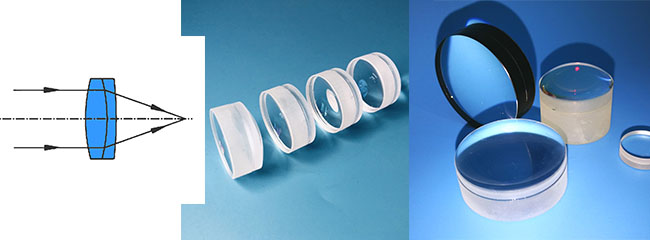ISO9001 Certified Professional Manufacturer & Supplier of Optics
+86-0431-87911611 admin@ytoptics.com
Contact us
-
 Email: admin@ytoptics.com
Email: admin@ytoptics.com
-
 Tel:86-0431-87911611
Tel:86-0431-87911611
-
 Add: 2# Automotive Innovation
Add: 2# Automotive Innovation
Jilin Province, China
Yutai Optics 一Doublet Lenses
An achromatic lens is a lens that is designed to limit the effects of
chromatic and spherical aberration,and is corrected to bring two
wavelengths (typically red and blue) into focus on the same plane.The
most common type of achromat is the achromatic doublet, the commonly
used materials are composed of flint glass and crown glass.
In the realm of precision optics, the achromatic doublet lens stands as a remarkable feat of micro-engineering. Composed of two optically distinct materials—typically crown glass and flint glass—bonded together, this lens assembly effectively corrects one of the most persistent aberrations in optical systems: chromatic aberration. The working principle relies on the difference in Abbe numbers between the two glass types. The positive lens, made of low-dispersion crown glass, is paired with a negative lens of high-dispersion flint glass, bringing the focal points of red and blue light into alignment and significantly improving image quality.

The design process of an achromatic doublet lens exemplifies the art of precise optical engineering. Designers employ sophisticated optical software to perform complex aberration-balancing calculations, carefully controlling curvature radii, center thickness, and bonding surface parameters. Material selection goes beyond matching refractive indices and Abbe numbers—thermal expansion coefficients, stress birefringence, and other physical properties must also be evaluated. Modern designs often use environmentally durable optical adhesives with precisely tuned refractive indices (typically between 1.48 and 1.55) to minimize interfacial reflections.
Manufacturing an achromatic doublet lens demands exceptional precision. Individual lens elements must achieve surface accuracy better than λ/4 (@632.8 nm), with center thickness tolerances within ±0.01 mm. The bonding process takes place in a cleanroom environment, where centrifugal bubble removal ensures defect-free adhesive layers. Advanced active alignment techniques reduce optical axis deviation to less than 1 arcminute, while interferometric testing monitors wavefront errors in real time. These high-precision techniques collectively ensure diffraction-limited performance.
This sophisticated optical component plays a vital role in multiple high-tech applications. In microscopy, it reduces axial chromatic aberration to below 0.1%; laser systems rely on it to maintain chromatic errors at the microradian level; and astronomical instruments use multi-element configurations to extend chromatic correction across broad spectral ranges. With advancements in computational optics, modern achromatic designs can now correct secondary spectrum, achieving sub-micron wavefront error across 400–1000 nm wavelengths. As this technology continues to evolve, the achromatic doublet lens remains a cornerstone in the pursuit of optical perfection.
In the realm of precision optics, the achromatic doublet lens stands as a remarkable feat of micro-engineering. Composed of two optically distinct materials—typically crown glass and flint glass—bonded together, this lens assembly effectively corrects one of the most persistent aberrations in optical systems: chromatic aberration. The working principle relies on the difference in Abbe numbers between the two glass types. The positive lens, made of low-dispersion crown glass, is paired with a negative lens of high-dispersion flint glass, bringing the focal points of red and blue light into alignment and significantly improving image quality.

The design process of an achromatic doublet lens exemplifies the art of precise optical engineering. Designers employ sophisticated optical software to perform complex aberration-balancing calculations, carefully controlling curvature radii, center thickness, and bonding surface parameters. Material selection goes beyond matching refractive indices and Abbe numbers—thermal expansion coefficients, stress birefringence, and other physical properties must also be evaluated. Modern designs often use environmentally durable optical adhesives with precisely tuned refractive indices (typically between 1.48 and 1.55) to minimize interfacial reflections.
Manufacturing an achromatic doublet lens demands exceptional precision. Individual lens elements must achieve surface accuracy better than λ/4 (@632.8 nm), with center thickness tolerances within ±0.01 mm. The bonding process takes place in a cleanroom environment, where centrifugal bubble removal ensures defect-free adhesive layers. Advanced active alignment techniques reduce optical axis deviation to less than 1 arcminute, while interferometric testing monitors wavefront errors in real time. These high-precision techniques collectively ensure diffraction-limited performance.
This sophisticated optical component plays a vital role in multiple high-tech applications. In microscopy, it reduces axial chromatic aberration to below 0.1%; laser systems rely on it to maintain chromatic errors at the microradian level; and astronomical instruments use multi-element configurations to extend chromatic correction across broad spectral ranges. With advancements in computational optics, modern achromatic designs can now correct secondary spectrum, achieving sub-micron wavefront error across 400–1000 nm wavelengths. As this technology continues to evolve, the achromatic doublet lens remains a cornerstone in the pursuit of optical perfection.
PREV : Principles and Applications of Visible High-Transmission Glass NEXT : Yutai Optics 一Optical Domes

TALK TO US 86-0431-87911611
86-0431-87911611
Call us now!
 86-0431-87911611
86-0431-87911611Call us now!
ONLINE CHAT
 2433808388
2433808388

